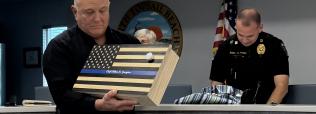Coastal Barrier Resources Act
What is CBRA?
The Coastal Barrier Resources Act (CBRA) of 1982 established the John H. Chafee Coastal Barrier Resources System (CBRS), comprised of undeveloped coastal barriers along the Atlantic, Gulf, and Great Lakes coasts. The law encourages the conservation of hurricane-prone, biologically-rich coastal barriers by restricting federal expenditures that encourage development, such as the National Flood Insurance Program and federal grants.
Who manages CBRA?
The U.S. Fish and Wildlife Service manages the CBRS maps and advises federal agencies, landowners, and Congress on properties included and federal expenditures allowed in CBRS.
Why does the U.S. need CBRA?
CBRA is a free-market approach to conservation. These areas can be developed, but federal taxpayers do not underwrite the investments. Nationwide, CBRA has successfully deterred major development in 97% of its units. CBRA saves taxpayer dollars and encourages conservation at the same time. CBRA has saved over $1 billion and will save millions more in the future.
How does CBRA affect NTB?
CBRA affects approximately 56% of North Topsail Beach’s land mass. Homes within CBRA are ineligible for participation in the National Flood Insurance Program. The public beaches within that unit are also ineligible for federal grants and aid. Because of the high expense of dune and beach projects, this prevents the town from properly maintaining the beach.
Why is the town advocating to be removed from CBRA?
In North Topsail Beach, over 2,500 homes host a seasonal population of almost 30,000. This development started before the CBRA passed Congress, making the area ineligible for inclusion in CBRS. A 1982 Onslow County zoning map also documents direct access to paved roads for all lots, with a 1981 Fish and Wildlife infrastructure review confirming “paved road throughout the unit.” By the time CBRA passed, the high-rise bridge connecting these lots to the mainland had been there for 14 years.
This significant infrastructure – evidence of development, which should have excluded North Topsail Beach from CBRA – was missed because of Fish and Wildlife’s flawed surveying methods.
Since the town's incorporation, the Board of Aldermen have worked to try and remove the town from CBRA.
What progress has the town made?
The Town continues to work toward correcting the L06 CBRA Map Unit through the Topsail Island Shoreline Protection Commission with former Congressman Mike McIntyre of Ward & Smith, P.A. Attorneys at Law and The Ferguson Group in Washington, D.C.. Mr. McIntyre provides monthly updates to the TISPC on the progress made with legislators on Capital Hill.
- In 2018 and again in 2019, Senator Tillis, the lead sponsor of the North Topsail Beach CBRA mapping bill (H.R. 2834/S.1406), along with Senator Burr and Representative Jones and then Rep. Rouzer (after Rep. Jones passing) introduced this legislation to fix the mapping issue.
- On March 20-24, 2023, Mayor McDermon, Alderman Leonard, and Manager Derian traveled to Washington, DC for a legislative visit. Click here to watch Alderman Leonards post DC presentation given at the April, 2023 Board of Aldermen meeting. Click here to view a post DC visit PowerPoint presentation by Alderman Leonard.
- On September 28, 2023, Alderman Tom Leonard, on behalf of the Town of North Topsail Beach appeared before the House Committee on Natural Resources, Subcommittee on Water, Wildlife and Fisheries to provide testimony at the legislative hearing in Washington DC on H.R. 2437. H.R. 2437 (Rep. Murphy), to revise the boundaries of a unit of the John H. Chafee Coastal Barrier Resources System on North Topsail Beach. You can view and listen to his testimony here.
Dr. Murphy's Introductory comments begin at 34:20, Alderman Leonard's testimony begins at 52:45, and Dr. Murphy's follow up questions and comments start at 1:18:30
- On November 15, 2023, House Resolution 2437, a bill cosponsored by Congressmen Murphy and Rouzer to direct the amendment of the Town of North Topsail Beach CBRA maps, was considered by the full House Committee on Natural Resources for a vote. The bill was passed along party lines. The bill will next be considered on the floor of the US House of Representatives.
- On April 15-17, 2024, Alderman Leonard and Manager Derian traveled to Washington, DC for a legislative visit. Click here to watch Alderman Leonard's post DC presentation given at the May, 2024 Board of Aldermen meeting. Click here to view a post DC visit PowerPoint Presentation by Alderman Leonard.
On March 5, 2025, House Resolution 1885, the "Town of North Topsail Beach Coastal Barrier Resources System Map Amendment Act of 2025" was introduced on March 5, 2025, by US Congressman Gregory Murphy and cosponsored by Congressman David Rouzer, and has been referred to the House Committee on Natural Resources.
Progress of HR - 1885 can be tracked at the following link:
https://www.congress.gov/bill/119th-congress/house-bill/1885/all-actions?s=1&r=1&q=%7B"search"%3A"hr1885"%7DOn May 20th, 2025,
Mayor Pro Tem Tom Leonard testified before the U.S. House of Representatives Water, Wildlife and Fisheries Subcommittee on May 20th to support Congressman Greg Murphy’s bill HR 1885 The Town of North Topsail Beach Coastal Barrier Resources System Map Amendment Act of 2025. Dr. Murphy (along with Representative Rouzer) has been assisting the town in correcting a mistake that occurred in 1983 when the Coastal Barrier Resources Act known as CBRA incorrectly included a portion of Topsail Island in what came to be the Town of North Topsail Beach. Mayor Pro Tem Leonard’s testimony describes the error made and the proposed changes to CBRS Map Unit L06 to exclude the developed areas of town. Federal funds such as Federal Flood Insurance, veteran loans, and other normal federal benefits are NOT available to properties in CBRS units. A big ‘Thank You’ to Mayor Pro Tem Leonard for representing our town in Washington.
Mayor Pro Tem Leonard’s testimony is available on YouTube. Congressman Murphy's statement about the bill begins at 0:9:00. Mayor Pro Tem’s testimony begins at 1:14:00. Congressman Hageman, Subcommittee Chair, questions to him begin at 1:22:00, and Congressman Elfreth, the ranking minority member, questions begin at 1:30:00.
Is your property in a CBRA Zone?
Check the NTB Shoreline Management Map (unofficial, cannot be used for insurance purposes).
An official CBRS Map is available on U.S. Fish and Wildlife Service (NC L06).
To understand how this may impact property in terms of insurance and mitigation assistance, please see the FEMA CBRS Fact Sheet.
Where Can I View CBRS Boundaries?
Historically, CBRS Boundaries were shown on FEMA Flood Insurance Rate Maps (FIRMs). Beginning 1/25/2019, CBRS boundaries will no longer be shown on FIRMs.
USFWS is the authoritative data provider for CBRS Boundaries. USFWS is not able to display maps dynamically and anticipates more frequent future updates. Up-to-date CBRS information is available here: U.S. Fish & Wildlife Service: CBRA Maps & Data.
For map information services, please contact the Floodplain Administrator Deb Hill.
How Do I Review Past reports?
Please click here to view Past CBRA Documents & Reports.
What can I do as a Property Owner?
Submit one of the applicable sample letters:
- For out of state property owners except for those who have a Representative on the House Committee on Natural Resources (Sample Letter #1)
- For those with a Representative on the Natural Resources Committee (Sample Letter #2)
A link to Natural Resources Committee members is here: https://naturalresources.house.gov/about/members.htm





